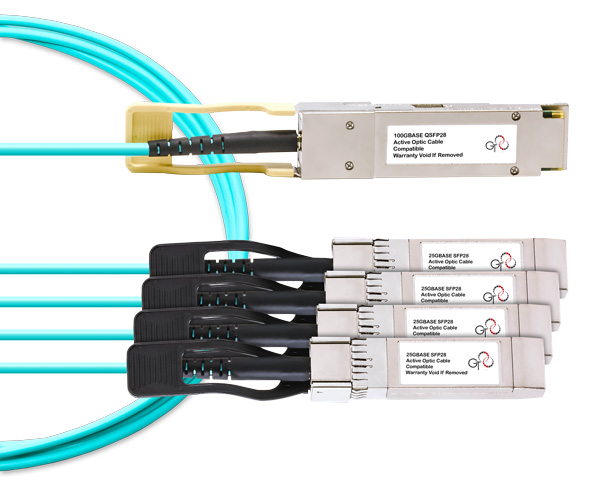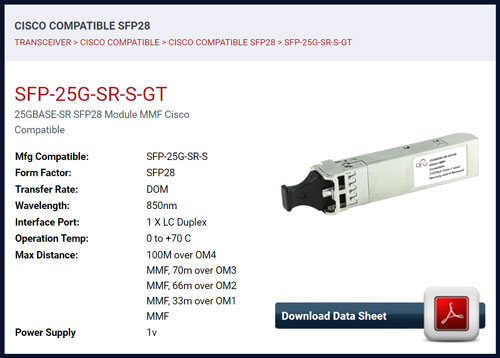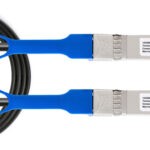25G Expansion in Networks and Servers
Supporting Network Architecture for Next Gen Data Speeds
As organizations push more traffic into their enterprise and private data centers, more bandwidth is required to move the data down into the fabric or top of rack. ToR architectures utilizing 10GbE to the server have the largest number of connections in data centers today, but these architectures are rapidly outgrowing 10GbE capabilities.
Benefits of 25G SFP28
Logical Upgrade Paths for Server Connections
SSFP+ is designed to operate at 10.3125 Gb/s whereas SFP28 is designed to operate at 25.78125 Gb/s. SFP28 utilizes the same familiar form factor as SFP+The SFP+ (enhanced small form-factor pluggable) is an enhanced version of the SFP that supports data rates up to 16 Gbit/s. Click to Read More, so new systems will be able to scale from 10Gb/s to 25Gb/s using the same ports. Other benefits to SFP28 modules include increased bandwidth, superior impedance control, and less crosstalk than a SFP+ solution. As the technology becomes more prevalent the price of 25G modules will begin to match that of 10G.
The SFP28 provides a new optimized path for server connections: 10G – 25G – 100G. 25G hierarchy also implements into 50G & 100GBASE interoperability, making it a backbone in newer systems today. Since 25G offers a more efficient use of hardware and a more logical upgrade path to 100G, many companies like Cisco, Microsoft and Intel have put it into practice rapidly.
Cost Effective Cabling Choices
25G SFP28 takes existing module form factors, such as SFP28 and QSFP28, and allows for a breakout connection that is configurable as either 25G per lane or the full 100G without changing the port on the front of switch. QSFP28 to SFP28 breakout cable provides various cabling choices for switches and servers. For example, a 100G QSFP28 to SFP28 breakout cable can be configured to a 4x 25G server or a 2x 50G server connection. A QSFP28 to SFP28 breakout cable is a cost-effective solution for high density, high speed I/O data center applications.

Market Forecast Shows Exponential Growth for 25/50/100GBase Infrastructure
The EthernetEthernet is the most popular and widely used Local Area Network (LAN) technology. An Ethernet network typically makes use of coaxial or twisted pair cables to transmit network traffic. Click to Read More industry continues to innovate and lay a path to higher networking speeds like 100GbE. The 25GbE standard has been developed to provide a simpler path to future Ethernet speeds of 50 Gbps, 100 Gbps and beyond. These implementations capitalize on the 25GbE specification adopted by the 25 Gigabit Ethernet Consortium. The specification makes use of single-lane 25 Gbps Ethernet links and is based on the IEEE 100GbE standard (802.3bj).
Considering the significant benefits and compelling economics of 25G, it is no surprise that the move from 10G and 40G to 25GbE is accelerating. The advent of 25G changes the connection speed of servers and the migration path to 50G or 100G (and beyond), which in turn accelerate the development of 25G. 25G SFP28 assemblies, as an important bridge in this progress, are booming now and Will continue to into the future.
Percent of Server Shipments

GigaTech Products SFP28 Compatibles
GigaTech supports a full line of 25G Transceivers, DAC Direct Attach Copper (DAC) cables use a passive twinax cable assembly with SFP+ transceiver housings built onto each end. These cables are typically available in lengths from 1 meter to 10 meters. DAC cables utilize little power, are low cost but do have bulkier (larger diameter) cables than fiber optic alternatives. Click to Read More, and AOCActive Optical Cables (AOCs) are specialized cables which make use of electrical-to-optical conversion circuits (transceivers) on each end of the cable. Click to Read More solutions for a wide range of switches, servers, and storage systems. These products are manufactured using the highest quality components and undergo extensive testing. Using GigaTech 25G solutions will allow you to maximize the capabilities of your network infrastructure to its fullest extent.
Direct Attach Copper (DAC) cables use a passive twinax cable assembly with SFP+ transceiver housings built onto each end. These cables are typically available in lengths from 1 meter to 10 meters. DAC cables utilize little power, are low cost but do have bulkier (larger diameter) cables than fiber optic alternatives. Click to Read More, and AOCActive Optical Cables (AOCs) are specialized cables which make use of electrical-to-optical conversion circuits (transceivers) on each end of the cable. Click to Read More solutions for a wide range of switches, servers, and storage systems. These products are manufactured using the highest quality components and undergo extensive testing. Using GigaTech 25G solutions will allow you to maximize the capabilities of your network infrastructure to its fullest extent.
Do you need cables with that? Transceivers require fiber cables in order to communicate. We have standard lengths on the shelf and can build custom cables to fulfill any unique requirements. Check out our fiber cables here: https://www.gigatechproducts.com/pg_fiber/
Summary
It is undeniable that 25G is a next generation data center option. 25 Gigabit Ethernet leverages the single-lane 25G physical layer technology to support 100G Ethernet offering higher speed, lower power consumption, and lower cost. If you are considering building a 25G network, GigaTech Products offers a variety of SFP28 options that are 100% compatible to OEM brands.